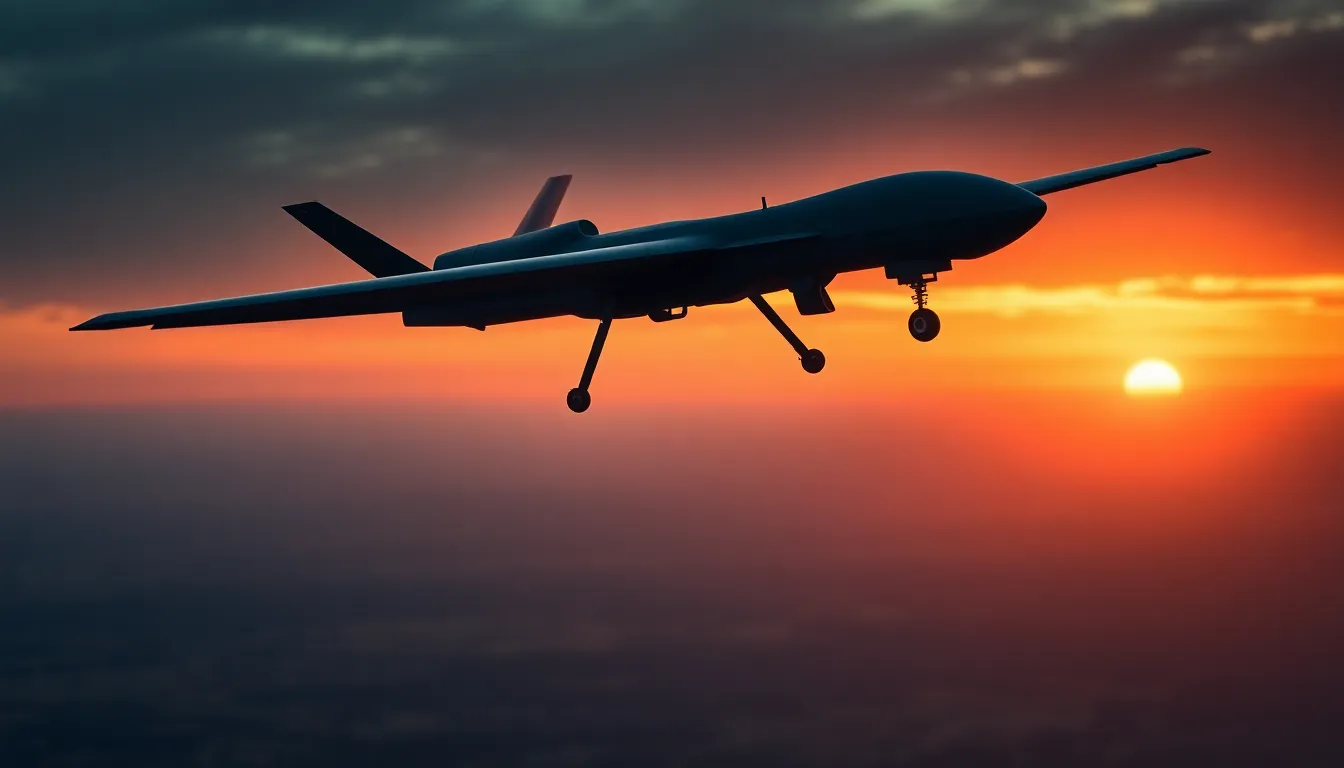In the world of geopolitics, timing is everything—especially when it involves airstrikes. Picture this: a tense standoff, diplomatic channels buzzing, and then, boom! The U.S. drops bombs on Iran. But what time did this dramatic moment unfold? It’s like the ultimate plot twist in a political thriller, and the clock is ticking.
As history unfolds, understanding the specifics of these events can feel like piecing together a jigsaw puzzle with a few missing pieces. From military strategy to international relations, knowing the exact timing sheds light on the motivations behind such actions. So grab your popcorn and settle in, because this is one story that’s packed with intrigue, tension, and a dash of irony. Let’s dive into the details of that fateful moment and unravel the mystery behind the timing of the U.S. bombing of Iran.
Table of Contents
ToggleOverview of the Incident
The U.S. bombing of Iran occurred on January 3, 2020, when a drone strike targeted Iranian Major General Qassem Soleimani. This operation took place at Baghdad International Airport in Iraq. It marked a significant escalation in U.S.-Iran tensions, which had already been rising due to various geopolitical issues. The strike killed Soleimani, along with several members of the Iranian militia.
Intelligence reports indicated that the U.S. government considered Soleimani a primary threat to American personnel and interests in the region. Threat assessments highlighted his involvement in orchestrating attacks against U.S. forces. The operation received authorization from President Donald Trump, who cited a need for decisive action to prevent imminent threats.
Public reactions varied across different sectors. Many officials praised the strike as a necessary measure for national security. In contrast, critics argued it could lead to wider conflict and destabilization in the Middle East. Shortly after the bombing, Iran vowed retaliation, enhancing fears of an escalating military confrontation.
Tensions further escalated when Iran launched missile strikes targeting U.S. bases in Iraq on January 8, 2020. The immediate aftermath of the U.S. bombing demonstrated how rapid responses can exacerbate ongoing conflicts. These developments highlighted the importance of understanding strategic military decisions in real-time. The incident serves as a pivotal moment in the analysis of U.S. military strategy in the region.
Timeline of Events

This section outlines critical dates and events surrounding the U.S. bombing of Iran. Understanding these moments illuminates the complexity of U.S.-Iran relations.
Key Dates
- January 3, 2020: A U.S. drone strike killed Iranian Major General Qassem Soleimani at Baghdad International Airport in Iraq. President Donald Trump authorized this operation, focusing on neutralizing threats to American personnel.
- January 8, 2020: In retaliation for Soleimani’s death, Iran launched missile strikes targeting U.S. bases in Iraq. This marked the beginning of heightened military tensions between the two nations.
- January 9, 2020: American officials reported no casualties from the missile strikes, yet many expressed concerns about the escalating conflict and possible retaliatory actions.
Significant Moments
- Escalation of Tensions: Soleimani’s influence on Iranian military activities established him as a key figure in U.S.-Iran hostilities. His assassination intensified disagreements over regional influence.
- Public Reactions: The response to the drone strike varied widely, with proponents arguing it enhanced national security. Critics warned the action could lead to further destabilization in the Middle East.
- Retaliatory Actions: Iran’s missile strikes indicated a shift in military strategy, showcasing their willingness to respond forcefully to perceived threats. The strikes heightened fears of an extended conflict involving multiple nations.
Reasons Behind the Bombing
The U.S. bombing of Iran in January 2020 stemmed from a complex interplay of political and military factors. Understanding these elements provides clarity on the motivations behind such drastic measures.
Political Context
Tensions between the U.S. and Iran escalated significantly in the months leading up to the bombing. Various incidents, including attacks on oil tankers and American interests in the region, heightened hostilities. Many viewed Major General Qassem Soleimani as a key figure in orchestrating destabilizing activities across the Middle East. Public opinion regarding U.S. foreign policy in the region had grown increasingly critical, compelling decision-makers to respond assertively. President Trump’s administration aimed to project strength against perceived threats to American personnel and allies. The backdrop consisted of ongoing negotiations over Iran’s nuclear ambitions, with diplomatic efforts frequently stalling. Such a volatile environment set the stage for the dramatic airstrike.
Military Objectives
The primary military objective behind the bombing focused on eliminating a high-profile target posing immediate threats. Soleimani’s influence over Iranian operations made him a significant player in regional conflicts. U.S. intelligence assessed that his actions directly endangered American forces. Striking him aimed to disrupt Iranian military strategy and deter future aggressions. Leadership believed that removing him would create a deterrent effect on Iran’s proxy forces. The operation sought to reaffirm U.S. commitment to safeguarding its interests in the Middle East. Additionally, the strike aimed to reinforce America’s military posture, demonstrating an unwillingness to tolerate Iranian provocations.
Impact of the Bombing
The U.S. bombing of Iran marked a significant turning point in regional dynamics, provoking immediate and long-term repercussions.
Immediate Consequences
The airstrike triggered an escalation of tensions, leading to Iran launching missile attacks against U.S. bases in Iraq on January 8, 2020. Casualties resulted from these retaliatory strikes, reflecting the heightened conflict in the Middle East. U.S. military personnel faced increased risks due to heightened tensions. Diplomatic relations further deteriorated, with the Iranian government vowing to respond forcefully to protect its interests. Critics of the bombing argued that it destabilized the region and could incite broader conflicts. Supporters pointed to the operation’s immediate goal, which was to neutralize a high-profile threat to American forces. Given this complex backdrop, the bombing had both strategic and unintended outcomes that shaped subsequent geopolitical interactions.
Long-Term Effects
Long-term effects included a shift in U.S.-Iran relations, characterized by increased hostilities and reduced diplomatic communication. Iran’s subsequent efforts to strengthen its military capabilities resulted in heightened expenditures on defense. Regional neighbors perceived the increased tensions, leading to altered security strategies by Gulf states. Analysts noted a rise in Iranian proxy activities throughout the Middle East, reflecting their broader strategy of asymmetric warfare. The bombing also deepened divides in U.S. foreign policy debates, influencing discussions around military intervention in the region. Over time, the bombing established a precedent for future U.S. actions concerning Iranian forces and interests, indicating a willingness to engage in targeted military operations to address perceived threats.
Reactions and Responses
Public and governmental responses to the U.S. bombing of Iran reflected deep divisions within the country. Many U.S. officials, including administration supporters, praised the strike for addressing what they perceived as an imminent threat. This group emphasized the need to protect American lives and interests in the region. Conversely, critics voiced significant concerns, highlighting the potential for escalating conflict and risks of retaliation from Iran. Progressive lawmakers and peace advocates argued that the operation could deteriorate U.S.-Iran relations further and lead to prolonged military engagement. Such polarized views underscored the broader debate around U.S. foreign policy and military intervention.
Internationally, nations reacted with a mix of condemnation and cautious support. Some allies, particularly those aligned with U.S. interests, viewed the bombing as a necessary action against a threatening figure. They underscored the need for a strong stance against Iranian military influence. In contrast, countries like Russia and Turkey criticized the airstrike, indicating it would exacerbate tensions in the Middle East. Iran’s government vehemently condemned the attack, promising swift retaliation. Such global reactions highlighted the complex geopolitical landscape shaped by the bombing and its aftermath.
The U.S. bombing of Iran on January 3, 2020, marked a pivotal moment in Middle Eastern geopolitics. This event not only escalated tensions between the two nations but also set the stage for significant military and diplomatic repercussions. As the world watched the unfolding drama, the complexities of U.S.-Iran relations became increasingly evident.
The immediate aftermath saw Iran’s retaliatory strikes and a heightened atmosphere of uncertainty. Understanding the motivations and timing behind such military actions remains crucial for analyzing future U.S. strategies in the region. The implications of this bombing continue to resonate, influencing both policy decisions and public opinion on military intervention in international conflicts.





